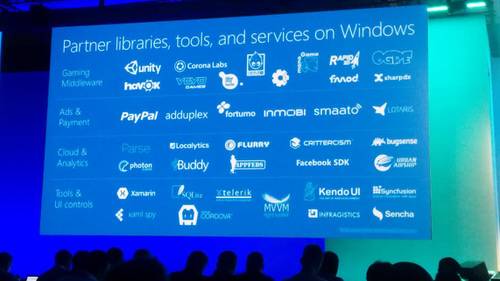
In the past, Microsoft’s Build Conference has catered to developers, but chiefly the old-school developers who built products for Microsft platforms. It took a turn to embrace Web and mobile developers when it announced it would release an existing JavaScript framework, WinJS, as open source.
See also: With The .Net Foundation, Microsoft Finally Bets Big On Open Source
WinJS is a set of JavaScript toolkits that assist developers in building HTML/CSS/JS applications, especially for Windows apps on the Web, Android and iOS. And now it’s an open-source project, so developers can contribute to it on GitHub even as they utilize it.
See also: Angular, Ember, And Backbone: Which JavaScript Framework Is Right For You?
Like Angular, Backbone, or EmberJS, WinJS is a framework that developers can choose to use on a per-project basis, depending on whether it meets their needs. There is no use case in which a developer must use WinJS in order to deliver a Windows app.
That’s why Microsoft is pinning its hopes on WinJS being more appealing than any of the existing frameworks. Here are some of the features they hope you’ll consider:
- WinJS is designed to help you build web-based apps, and yes, that includes HTML5. A slew of distinct components provide prewritten code for useful features like lists and grids so you can shortcut your app. The photo at the top of this article shows just what span and scope these libraries have. You can also check out the WinJS preview to try out some of the libraries without doing a build.
- WinJS’s ultimate goal? According to Josh Williams, Principal Software Design Engineer at Windows, it’s to make Windows apps look more like what today’s consumers expect apps to look like. “Gmail, for example, gave an app like feel, and apps have a certain look and feel. People expect that and that’s what it is,” he told ReadWrite at Build 2014 in San Francisco.
- Node.js is a required component of building WinJS on your local machine. Presumably, by working on top of Node, WinJS is able to deal especially well with asynchronous tasks, like chat and other user interactions, within apps. However, this is by no means unique as most JavaScript frameworks are designed to play well with Node.
- With so many other JS frameworks out there, what sets WinJS apart from the pack? WinJS libraries especially cater to the needs of business apps on the Web, said Paul Gusmorino, Principal Program Manager at Microsoft. “WinJS is [user interface] focused and it allows for a similar look across devices,” he said to ReadWrite at Build 2014.
- If you don’t want to stop working in your preferred JavaScript framework but still want to use WinJS features, Microsoft is one step ahead of you. There are already adaptors for the Angular, Knockout and JQuery frameworks built-in, so your Angular developed project, for example, could incorporate WinJS library features.
WinJS is getting a lot of early attention, but it’s hard to say yet if it’ll become anyone’s favorite framework. Its developers say WinJS is especially streamlined for business apps, consistency across platforms, and a user-focused experience, but you could say the same for competitors like Angular, Backbone, Ember and Knockout. Making apps “look and feel like apps” isn’t exactly a unique goal.
Probably the best thing WinJS has going for it are all the JavaScript libraries that Microsoft has included into the framework, which make it easy to develop complex code quickly. The trial page shows off beautiful, interactive widgets that are easy to incorporate. And the fact that you can use these features with a framework you already trust, like Angular, may tempt many developers into giving it a try.
An earlier version of this story mischaracterized the nature of the Build conference and Microsoft’s WinJS open-source announcement. ReadWrite regrets the errors.
Photo by Dan Rowinski for ReadWrite









